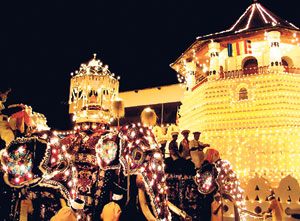The Aluthnuwara Perahera, which ends today, is the oldest perahera in the hill country. Combining traditions of the south and the Kandyan region, this religious event heralds the beginning of the Kandy Esala Maha Perahera.
On the night of July 21 four “kap” (saplings from a milk-bearing tree) will be cut with much ceremony at the Aluthnuwara Devale for the “kap” planting ceremonies at the four devales in Kandy on July 22.
Yesterday was the final night of the month-long Aluthnuwara perahera, which ends with the day perahera today. Basnayake Nilame Mohan Pannabokke, who is also Basnayake Nilame of the Maha Vishnu Devale, presided at the ceremony.
Aluthnuwara is off Hingula where there is a small shrine dedicated to god Dedimunda, who rules over the hills of Kandy.
 |
| Kandy Perahera: The continuation of an ancient tradition |
An ambalama built by an ancient Sinhalese queen stands at the entrance to the devale.
In the old days, Aluthnuwara was on the way to Sri Pada. It was also on the road taken by the “enemy”, such as the Portuguese, who sought to invade the Kandyan Kingdom. The invaders would ransack the temples and steal their treasures. They were interested in the gold and silver in the temples.
The Aluthnuwara Devale dates back to the period of Parakrama Bahu. The present devale building is said to have been built in the period of Molligoda Maha Adikaram, whose walauwwe still stands, close to the devale, which is dedicated to the mighty god Dedimunda, who is believed to have control of the demons or yakshayas.
There are a number of stories about god Dedimunda. According to one story, Dedimunda is the son of the Yakshaya Purnath, born of the Naga virgin, Erandathi. He is also called Sudumal, and is said to be the grandson of Vessamuni. Another story says that a Bandara from the Kandyan Kingdom became a devatha, on the basis of merits done in a previous life. He landed at Devundra in Sri Lanka and then proceeded to Seenigama and later to Aluthnuwara.
While Vishnu or Upuluvan is depicted wearing blue, Dedimunda is shown wearing white robes and holding a cane and a sceptre. It is said that Dedimunda stood by the Buddha when Maraya sent his daughters to seduce him. The British scholar Hugh Nevill (1847-1897) describes Dedimunda variously as a Devata Bandara, Veera Vikum, Yahala Bandara and Yahal Deviyo.
It is recorded that Parakrama Bahu II travelled through Aluthnuwara on his way to Sri Pada.
Other scholars trace the origin of Aluthnuwara to a period before Parakrama Bahu, pointing to a cave culture and a time when vihares were built. One such vihare is found on a hill called Udugala, a short distance from Aluthnuwara. The vihare dates back to pre-Dambadeniya times. Today it is known as the Galgama Raja Maha Vihare. Legend says the King gifted a village called Paddawelpaya to this vihare.
Around 1258, Parakrama Bahu fell sick and was declared of unsound mind. His ministers, led by Deva Pathiraja, sought the help of god Upulvan of Devundera. Deva Pathiraja personally went to Devundera and held a perahera for seven days to bring blessings on the King, but without success. On the seventh night after the perahera, god Upulvan appeared in the form of a Brahmin and told Deva Pathiraja that the king’s sickness could not be cured, as it was part of his karma from a previous life.
Deva Pathiraja expressed a wish to build a devale at Dambadeniya, but was overruled by the queen, who wanted to build a devale at Aluthnuwara. And so the devale dedicated to god Upulvan came to be. The site was chosen by Queen Sunethra and the chief priest of the cave vihare.
After the devale was put up, attention turned to installing a statue of god Upulvan. A figure of Upulvan was carved out of a sapu tree. The famous artist Pathiraya was commissioned to carve the statue. It is said that this was the last work he created.
A figure of Queen Sunethra was carved by the same artist and put up alongside the figure of the god Upulvan.
There seems to be some confusion between the gods Vishnu and Upulvan. According to a ballad (Sataravaran Malyahana Kavi) from the Gampola period, Vishnu was formerly known as Khirelli, one of the four guardian gods of Sri Lanka.
Sanctifying the completed devale was another big undertaking. The carved figures were not deposited in the devale , but in the cave vihare.
From this vihare a procession of elephants, dancers and others proceeded to the devale at Malwatta. There is no indication that banners were used in this perahera. Could this be the origin of the perahera of the central hills? There is no evidence that peraheras existed in the hills before this period.
The peraheras for the four Devales came long after the Aluthnuwara Perahera.
The original site of the statue of god Upulvan was under a huge mara tree. King Senarath later moved the statue and the Devaraja Palikhada to Kandy.
The god Upulvan plays an important role in the life of the people of Sri Lanka, according to the scholar Dr. H. E. Hettiarachchi. Upulvan appears in Hindu writings, but his presence was felt with the arrival of Prince Vijaya in Sri Lanka. He was also given a responsibility to protect Buddhism.
The Kandy Esala Perahera, however, gained prominence in 1753, with the arrival of Upali Thera from Siam (Thailand ). Upali Thera brought the Upasampada or higher ordination of Buddhist monks, during the reign of King Kirthi Sri Rajasinghe. |

